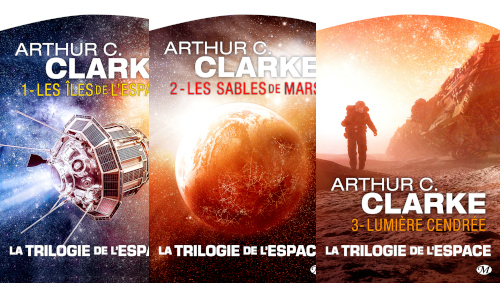The Space Trilogy

Following Childhood’s End, my exploration of Arthur C. Clarke books made me read three other works regrouped into a series entitled The Space Trilogy, which are Islands in the Sky, The Sands of Mars, and Earthlight, or Les îles de l’espace, Les sables de Mars, and Lumière cendrée in French. Even if they’re not really related between each others, these novels are early Clarke’s works that take place in space with the point of view of different kind of people. This article will be a short review of these stories.
Islands in the Sky
Released in 1982, Islands in the Sky is the story of an ordinary sixteen teenager, Roy Malcom, who won a contest and got the opportunity to travel in the human cislunar space settlement during the first half of the 21th Century.
The story is written using the first person as Roy’s travelogue during all the steps of his journey in space. With at first, the preparation and the trip explaining his acclimatising of zero-G environment. Later, he his welcomed at the Inner Station, located around 8 000 kilometres above the Earth, by the Commander Doyle who introduces him to a team of apprentices. With this team of students, Roy will discover the life in space and encounter various adventures in just two weeks.
This story is pretty nice and accessible. As usual with Clarke’s work, the setting is detailed and every precise regarding the orbiting of the Stations, the stakes of the life in space, and the various category of populations we could encounter there. A very accurate fictional tour written in an optimistic way that helps the main character to discover his future way.
The Sands of Mars
Released in 1951, The Sands of Mars is a story about the red planet’s colonisation. It’s Clarke’s first published novel actually. It features Martin Gibson, a famous science fiction novelist travelling to a three months trip to Mars as a guest aboard the Ares, the first commercial space ship, during its maiden flight. There, he would meet the Chief Executive of Mars and the mayor of the first colonies established inside inflated domes. During his trip, Gibson will learn about the life on Mars, and also on himself regarding the Aries crew members he befriended with.
Written ten years before humans achieved space flight, the novel remains pretty accurate on various details such as zero gravity environments and ideas regarding the colonisation of a new planet. The Mars imagined by Clarke was inspired by the contemporary knowledge about it, even if some ideas such as Martian canals were already discredited. Some fun fact is the still usage of low-tech office tools such as typewriters and carbon paper while computer technology would have expanded. The book explores the idea of inflated domes that connects the various parts of the colony and the usage of specifically designed vehicles to travel on the red planet.
The story revolves mostly around two main topics. One is the relationship between Earth and Mars which reminds a lot the American continent colonisation by the Europeans. In this novel, the settling is still very fresh and driven by a global government entity, not countries competing. And it’s also considered by lot’s of people as a waste of public money. However, the same idea of growing Independence and “Martian” identity is visible in the story. The other main part is more personal to Gibson, because the youngest Ares crew member, a student and aspiring astronaut named Jimmy, put him back twenty-years ago in a time when the novelist was an engineering student himself who dropped his studies because of a nervous breakdown.
The Sands of Mars has some relationship with later Clarke’s work such as the Saturn exploration mentioned in this story that would be later featured in 2001 : A Space odyssey. Orbital spaces stations are also described here, similar to the ones developed in Islands in the Sky.
Earthlight
Published in 1955, Earthlight (Lumière cendrée in French - translation based on the Ashen light supposed subtle glow that claimed to be seen on the night side of the planet Venus, in this case the Earthlight is as seen from the Moon) is the third part of the “Space Trilogy”. It features Bertram Sadler, an Earthian observant sent on a Moon Observatory to evaluate the cost usages of the science projects. Actually, Sadler is a secret agent from the Earth government investigating about confidential data leaks detected in this facility to the Federation. Undercover, Sadler has for mission to discover the spy before a major world crisis happen between the Earth and the other planets Federation.
Actually, if I’ve recalled the idea of the colonisation and the independence wish during my reading of The Sands of Mars, Earthlight is more advanced in this topic and is actually mentioning the American example several times to explain the geopolitical situation. Earth is a united government with the sovereignty over the Moon meanwhile several space settlement such as Mars and Venus have formed a Federation. Because of political tensions between the Federation and the Earth, a war is about to erupt.
So in Earthlight, the story develops into a conflict escalation between two major entities. We follow this narrative as an investigation that also explores the Moon facilities from the perspective of someone who never been there. In this novel, Clarke proposed a very interesting display of the cities in the Moon, the installations, and also the culture. One nice idea is the language difference. On the Moon, the people are speaking more directly and simply, the protagonist thinking it was maybe to not waste air. It’s a comprehensive descriptive novel and I’ve enjoyed this because the background and the setting is very consistent. The various elements are associated to accurate technological and scientific ideas regarding the space mechanics such as orbital movements or travelling. One chapter is dedicated to a space battle between Federation cruisers and the Earthian facilities told with a lot of technical details and a pretty nice rhythm. Later, the aftermath of the battle is explained on another perspective and tells about a space rescue.
A nice story, longer than the two other, but well executed.
About these three novels
Despite being unrelated, I’ve understood why these stories have been republished as a series. Actually, it’s the same idea with an escalation is stakes and intensity.
In the Islands in the Sky, we follow a teenager doing a leisure travel and discovering the space stations around the Earth. The relation between the Earth and the colonised planets is barely mentioned.
In The Sands of Mars, we develop more the colonisation of planets and the story is mainly told from the Martian perspective, but as seen by an Earthian eyes. Mars remains an Earth-managed colony.
In Earthlight, we are more advanced and now the geopolitical theatre is more complexe with independent nations in Planets regrouped as a Federation with the threat of a war.
So we have here a timeline that could represent the various stages of evolution of human development in space with these three story.
My next reading is The Thing written by John W. Campbell, the novel behind some movies of the same named including John Carpenter’s.
